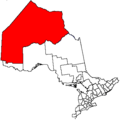Webequie First Nation: Difference between revisions
GreenC bot (talk | contribs) Move 1 url. Wayback Medic 2.5 |
No edit summary Tags: Reverted Visual edit |
||
| Line 42: | Line 42: | ||
}} |
}} |
||
'''Webequie First Nation''' is located on the northern peninsula of Eastwood Island on [[Winisk Lake]], 540 km (336 mi) north of [[Thunder Bay]] in [[Ontario]], [[Canada]]. Webequie is a fly-in community with no summer road access. The primary way into the community is by air to [[Webequie Airport]] or [[winter road]], which connects to the [[Northern Ontario Resource Trail]]. |
'''Webequie First Nation''' is located on the northern peninsula of Eastwood Island on [[Winisk Lake]], 540 km (336 mi) north of [[Thunder Bay]] in [[Ontario]], [[Canada]]. Webequie is a fly-in community with no summer road access. The primary way into the community is by air to [[Webequie Airport]] or [[winter road]], which connects to the [[Northern Ontario Resource Trail]]. |
||
== Location == |
|||
Webequie is located on the northern peninsula of Eastwood Island on the [[Winisk Lake]], 540 kilometers north of the city of [[Thunder Bay]], or 450 kilometers north of the town of Sioux Lookout. |
|||
Access is only by air or a seasonal winter road. There is no year-round road access. The nearest year-round road access is the town of [[Pickle Lake]], 250 km to the southwest, or the town of [[Nakina, North Carolina|Nakina]], 320 km to the southeast. Charter air service to Webequie is available from both of these communities.<ref>{{Cite web |title=Webequie First Nation - Webequie, Ontario |url=http://www.webequie.ca/article/location-118.asp |access-date=2024-05-16 |website=www.webequie.ca}}</ref> |
|||
The First Nation have the 34,279 ha '''Webequie [[Indian reserve]]'''. The Webequie or '''Webiqui Indian Settlement''' also have reserve status. Webequie First Nation is a member of the [[Matawa First Nations]], a Regional Chiefs' Council and a member of the [[Nishnawbe Aski Nation]]. |
|||
== Population == |
|||
The registered population of Webequie was 1320 persons in September 2015, of which the on-reserve population was over 900.<ref name="about2">{{cite web|url = http://www.northsouthpartnership.com/pdfs/Webequie%20Assessment%20Report%20NSP%202007r.pdf |title=Webequie Assessment Report|publisher=North-South Partnership for Children|access-date=2011-06-07}}</ref> The reserve is entirely surrounded by territory of the [[Unorganized Kenora District]]. |
The registered population of Webequie was 1320 persons in September 2015, of which the on-reserve population was over 900.<ref name="about2">{{cite web|url = http://www.northsouthpartnership.com/pdfs/Webequie%20Assessment%20Report%20NSP%202007r.pdf |title=Webequie Assessment Report|publisher=North-South Partnership for Children|access-date=2011-06-07}}</ref> The reserve is entirely surrounded by territory of the [[Unorganized Kenora District]]. |
||
Revision as of 18:51, 16 May 2024
Webequie | |
|---|---|
| Webequie Indian Reserve | |
| Coordinates: 52°57′N 87°22′W / 52.950°N 87.367°W | |
| Country | |
| Province | |
| District | Kenora |
| First Nation | Webequie |
| Area | |
| • Land | 303.41 km2 (117.15 sq mi) |
| Population (2015)[1] | |
| • Total | 1,300 |
| • Density | 2.0/km2 (5/sq mi) |
| Website | www.webequie.ca |
Webequie First Nation is located on the northern peninsula of Eastwood Island on Winisk Lake, 540 km (336 mi) north of Thunder Bay in Ontario, Canada. Webequie is a fly-in community with no summer road access. The primary way into the community is by air to Webequie Airport or winter road, which connects to the Northern Ontario Resource Trail.
Location
Webequie is located on the northern peninsula of Eastwood Island on the Winisk Lake, 540 kilometers north of the city of Thunder Bay, or 450 kilometers north of the town of Sioux Lookout.
Access is only by air or a seasonal winter road. There is no year-round road access. The nearest year-round road access is the town of Pickle Lake, 250 km to the southwest, or the town of Nakina, 320 km to the southeast. Charter air service to Webequie is available from both of these communities.[2]
The First Nation have the 34,279 ha Webequie Indian reserve. The Webequie or Webiqui Indian Settlement also have reserve status. Webequie First Nation is a member of the Matawa First Nations, a Regional Chiefs' Council and a member of the Nishnawbe Aski Nation.
Population
The registered population of Webequie was 1320 persons in September 2015, of which the on-reserve population was over 900.[3] The reserve is entirely surrounded by territory of the Unorganized Kenora District.
Webequie is policed by the Nishnawbe-Aski Police Service, an Aboriginal-based service.
History
When the Treaties were created between the Canadian government and the Aboriginal people of Canada, Webequie was mistakenly listed as part of the community of Fort Hope. They lived under this error until May 1985, when they were recognized as a distinct band. Despite this, the people of Webequie had to fight until February 15, 2001, to achieve full reserve status.[4]
The name "Webequie" comes from the Anishinini word webikwe meaning "shaking head."
The community is profiled in the 2016 short documentary film The Road to Webequie.[5]
In 2017, the provincial government of Ontario pledged support for the construction of a road that would connect Webequie, Nibinamik and the Northern Ontario Ring of Fire to Ontario Highway 599 at Pickle Lake.[6]
References
- ^ a b "Webequie census profile". 2011 Census of Population. Statistics Canada. Retrieved 25 July 2015.
- ^ "Webequie First Nation - Webequie, Ontario". www.webequie.ca. Retrieved 2024-05-16.
- ^ "Webequie Assessment Report" (PDF). North-South Partnership for Children. Retrieved 2011-06-07.
- ^ "The Founding of Webequie". Webequie First Nations. Retrieved 2011-06-07.
- ^ "TIFF Short Docs: ‘Hand. Line. Cod’, ‘The Road to Webequie’". Point of View, October 3, 2016.
- ^ "Ontario pledges 'support' for year-round road access to 3 remote First Nations". CBC Thunder Bay, August 21, 2017.


